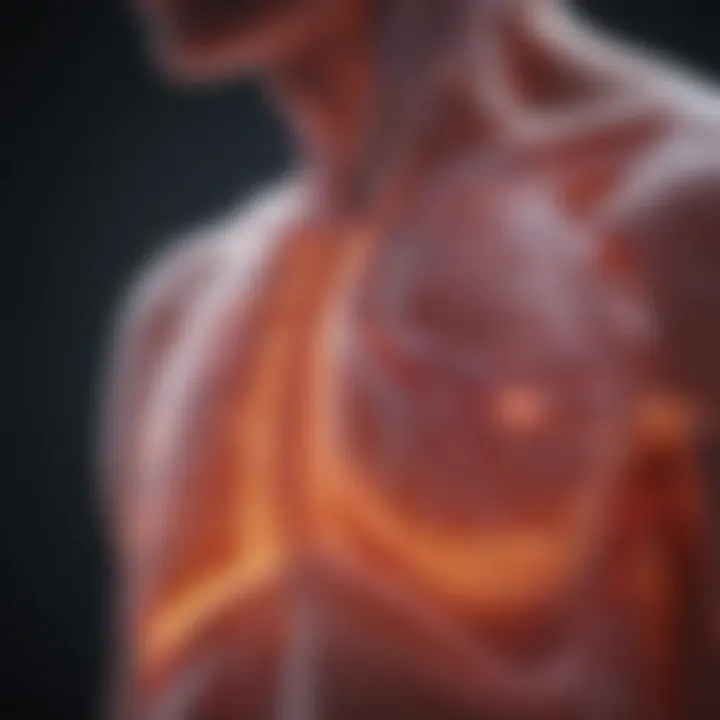Understanding Moderate COPD: Management and Implications


Intro
Chronic Obstructive Pulmonary Disease (COPD) affects millions globally and is a significant public health concern. Moderate COPD denotes a critical stage within the disease's progression, marked by unique pulmonary function limitations that require immediate attention. This section aims to inform readers about the challenges faced by patients and present a comprehensive framework for understanding its implications and management strategies.
The complexity of moderate COPD necessitates an exploration of various components: clinical significance, diagnostic criteria, symptoms, and treatment options. By unraveling these elements, healthcare professionals, educators, students, and researchers can develop a clear perspective on the condition. Knowing these details fosters better patient care and informs management strategies to improve daily life for those affected.
As we delve deeper into the nuances of moderate COPD, we highlight the importance of accurate diagnosis, timely intervention, and ongoing management to ensure optimal patient outcomes. The information contained within this article aims to demystify moderate COPD, making it accessible to a wider audience without diluting the intricacies of medical terminology.
Research Highlights
Overview of Key Findings
Moderate COPD represents a stage where patients experience non-negligible symptoms and functional limitations. Research indicates that education about the disease can lead to improved compliance with treatment and overall quality of life. Awareness of how moderate COPD can evolve into more severe forms underscores the need for vigilant management practices.
Significance of the Research
Understanding moderate COPD is vital not only for affected individuals but also for healthcare providers. Insights gained from recent studies contribute to developing tailored management plans that enhance patient support and care. Moreover, recognizing the progression patterns of this condition allows for timely interventions that can positively impact the patient's trajectory.
Effective management of moderate COPD can reduce exacerbations and improve overall lung function, leading to better quality of life for patients.
Understanding Symptoms of Moderate COPD
Moderate COPD is characterized by a range of symptoms that significantly impact everyday life. These can include:
- Shortness of breath, particularly during physical activities.
- Chronic cough, often accompanied by phlegm.
- Wheezing, reflecting airflow obstruction.
- Increased sputum production that may change in color or consistency.
These symptoms can vary in intensity and often contribute to reduced physical activity, which can further exacerbate the condition over time.
Diagnostic Criteria
To classify a patient as having moderate COPD, healthcare professionals rely on lung function tests, primarily the spirometry test. Key criteria for diagnosis include:
- Forced Expiratory Volume (FEV1) between 50% and 80% of the predicted value.
- Patient history of exposure to lung irritants like tobacco smoke or environmental pollutants.
- Recognition of symptoms mentioned earlier through patient interviews and clinical assessments.
Establishing a correct diagnosis is essential to initiate effective management strategies timely.
Treatment Approaches
Managing moderate COPD often requires a multifaceted approach. Treatment may involve:
- Bronchodilators to relax airway muscles and improve airflow.
- Corticosteroids to reduce inflammation.
- Oxygen therapy in advanced cases to ensure adequate oxygen levels.
- Pulmonary rehabilitation programs that emphasize exercise training, education, and support.
Personalized treatment plans consider individual symptoms, preferences, and overall health status. Patient participation is crucial for successful outcomes. The goal is to empower patients, equipping them with tools and knowledge to navigate their condition effectively.
Synthesizing Information
Understanding moderate COPD involves grasping its implications on daily life, recognizing symptoms, and engaging with effective management strategies. Knowledge transfer between healthcare providers and patients plays an integral role in fostering better health outcomes. Continuous research in this area is pivotal in shaping future intervention strategies, enabling patients to live healthier and more fulfilling lives despite their challenges.
By prioritizing education and awareness, stakeholders can significantly enhance the quality of care delivered to those with moderate COPD.
Preamble to COPD
Chronic Obstructive Pulmonary Disease (COPD) is a significant global health concern, warranting thorough understanding among students, researchers, educators, and healthcare professionals. This section serves as an essential foundation for grasping the complexities of moderate COPD as it lays out the parameters defining the condition, its ramifications, and the approaches to manage it effectively.
The discussion on COPD encompasses not merely the medical definitions but also the physiological and psychosocial aspects associated with this disease. This understanding can aid in recognizing the broader implications of moderate COPD on patients' lives, their families, and society at large. Through a detailed examination of its definition and global prevalence, we aim to equip the reader with critical insights that foster better management and support strategies.
Definition of COPD
Chronic Obstructive Pulmonary Disease is an umbrella term that encompasses progressive lung diseases. These include emphysema and chronic bronchitis, which are primarily caused by long-term exposure to harmful irritants, including cigarette smoke and environmental pollutants. Patients suffering from COPD experience persistent respiratory symptoms and airflow limitations due to the damage to the airways and the lungs.
The diagnosis is often confirmed via spirometry, which measures the amount of air a person can exhale forcefully in one second (Forced Expiratory Volume in the First Second or FEV1). A reduction in FEV1 indicates the presence of airflow obstruction and classifies the severity of COPD, ranging from mild to very severe.
Global Prevalence
The global prevalence of COPD paints a concerning picture. The World Health Organization estimates that over 250 million people are affected by COPD worldwide. It ranks as the third leading cause of death globally, accounting for an increasing percentage of morbidity and mortality associated with respiratory diseases.
- Risk Factors: Key factors contributing to COPD include:
- Tobacco smoking
- Occupational exposure to harmful dust or chemical fumes
- Indoor air pollution from biomass fuel use
- Genetic factors, such as Alpha-1 antitrypsin deficiency
The prevalence of COPD varies across regions, with high rates commonly reported in low- and middle-income countries. This emphasizes the need for targeted interventions and awareness programs in diverse contexts. Understanding COPD on a global scale can enhance appreciation of its burden and the necessity for effective management and intervention strategies.
"COPD represents a significant challenge for public health, leading to both physical and societal burdens."


By addressing these fundamental concepts of COPD, we create a scaffold for discussing more complex issues related to moderate COPD in subsequent sections, providing a holistic view of its impact and management.
Understanding Moderation in COPD
Moderate Chronic Obstructive Pulmonary Disease (COPD) represents a critical phase in the continuum of pulmonary health. It is essential to understand this stage because it delineates a clear distinction from both mild and severe forms of the disease. Knowing how moderate COPD fits within the larger spectrum enables both patients and healthcare providers to better grasp treatment options and necessary lifestyle adjustments. This understanding fosters a more targeted approach to management and can significantly influence quality of life outcomes.
The identification of moderate COPD carries several implications. For patients, it signifies a turning point where interventions can have a substantial impact on preventing progression. For healthcare professionals, it emphasizes the need for meticulous monitoring and tailored strategies to mitigate symptoms and enhance the patient's functional capacity.
Furthermore, moderate COPD is characterized by certain physiological parameters that can guide effective management. Recognizing thresholds and symptoms that denote this stage can lead to timely interventions and improve the prognosis of those affected. Thus, discussing moderate COPD is not only essential for academic knowledge but also for practical, everyday application in clinical settings.
What Classifies Moderate COPD?
Moderate COPD is typically classified using the Global Initiative for Chronic Obstructive Lung Disease (GOLD) guidelines, which focus on measuring airflow limitation through spirometry. In this context, moderate COPD is characterized by a Forced Expiratory Volume in one second (FEV1) of 50% to less than 80% of the predicted value. This measurement indicates a noticeable level of obstruction that can lead to recurring respiratory symptoms.
Patients with moderate COPD often experience increased dyspnea and chronic cough. They may also have a reduced capacity for physical activity, impacting daily life. Early diagnosis is crucial as it opens up a range of management strategies that can prevent further decline.
Distinction from Mild and Severe COPD
To truly comprehend moderate COPD, it is important to contrast it with mild and severe forms:
- Mild COPD is generally characterized by a FEV1 of 80% or more of the predicted value. Symptoms may be minimal and could go unnoticed.
- Severe COPD presents a FEV1 of less than 50%. Patients often experience significant breathlessness and limitations in activities.
Between these two extremes lies moderate COPD, where symptoms become apparent, but the individual may still maintain a certain degree of functionality. This stage is crucial because patients often fall into a category where they can still benefit significantly from interventions but need to take the condition seriously to prevent further deterioration. The management of moderate COPD typically involves a combination of pharmacological treatments, lifestyle changes, and regular monitoring to maintain health and reduce risks.
Understanding the classification of COPD is fundamental for tailoring effective management strategies.
Pathophysiology of Moderate COPD
The pathophysiology of moderate Chronic Obstructive Pulmonary Disease (COPD) is fundamental to understanding the disease’s implications and management. Recognizing the underlying biological and physiological processes is crucial for effective treatment strategies and improving patient outcomes. This section will outline the mechanisms of lung damage and the role of inflammation, which are central to the progression and management of moderate COPD.
Mechanisms of Lung Damage
Moderate COPD is characterized by significant airflow limitation, primarily due to structural changes in the lungs. The mechanisms of lung damage are complex and involve several factors.
- Airway Remodeling: In response to chronic irritation from environmental pollutants and smoking, the airways undergo remodeling. This includes thickening of the airway walls, increased mucus production, and a narrowing of the bronchi. Such changes restrict airflow, leading to symptoms such as shortness of breath and wheezing.
- Alveolar Destruction: Emphysema, one of the key components of COPD, results from the destruction of alveoli. The loss of alveolar walls reduces the surface area available for gas exchange, contributing to decreased oxygenation in the blood. Consequently, patients experience significant respiratory distress even during minimal exertion.
- Impaired Gas Exchange: As lung function declines, the ability to exchange oxygen and carbon dioxide becomes impaired. This can lead to hypoxia (low blood oxygen levels) and hypercapnia (high carbon dioxide levels), further exacerbating respiratory failure.
Understanding these mechanisms is critical for developing targeted therapies that address the root causes of lung damage in moderate COPD.
Role of Inflammation
Inflammation plays a key part in the pathophysiology of moderate COPD. It is not only a response to injury but also a contributing factor to the progression of the disease. The inflammatory response involves both the innate and adaptive immune systems.
- Chronic Inflammatory Response: Inhalation of harmful substances triggers a persistent inflammatory response in the bronchi, leading to the recruitment of immune cells such as neutrophils and macrophages. This results in the release of proteolytic enzymes that can damage lung tissue and contribute to airway changes.
- Cytokine Release: Various cytokines, such as tumor necrosis factor-alpha (TNF-α) and interleukins, are released during the inflammatory process. These substances promote further inflammation and facilitate the progression of COPD by sustaining tissue damage and remodeling.
- Systemic Inflammation: In addition to pulmonary inflammation, moderate COPD often leads to systemic inflammation, which can affect other organ systems. This generalized inflammatory state can have implications for comorbidities such as cardiovascular diseases.
The interplay between lung damage and inflammation in moderate COPD emphasizes the necessity for comprehensive management strategies that address both pulmonary and systemic concerns. By understanding the pathophysiological aspects of moderate COPD, healthcare providers can tailor interventions that are more effective for patients.
Symptoms of Moderate COPD
Understanding the symptoms associated with moderate Chronic Obstructive Pulmonary Disease (COPD) is crucial. Symptoms not only indicate the progression of the disease, but they also guide decision-making in treatment and management strategies. Moderate COPD typically shows a certain pattern of symptoms that can significantly affect a person's quality of life. Recognizing these symptoms early can make a crucial difference in creating an effective management plan.
Common Respiratory Symptoms
Common respiratory symptoms often characterize moderate COPD, altering the respiratory function of individuals. These symptoms may include:
- Chronic cough: A persistent cough that may produce mucus is often one of the first symptoms patients notice. This can become a daily nuisance, affecting communication and social interactions.
- Shortness of breath (dyspnea): Many patients experience increased breathlessness, especially during physical activities. While some may find this discouraging, understanding the underlying reasons can foster better coping strategies.
- Wheezing: A whistling sound during breathing occurs due to narrowed airways. Wheezing can be particularly distressing, indicating an exacerbation or acute episode of COPD.
- Increased sputum production: Patients may notice an increase in the volume and frequency of sputum they produce. This can vary from clear to colored secretions, offering further clues about possible infections or the severity of airflow limitation.
These symptoms often worsen with exacerbations, which are acute phases of worsening lung function. Being vigilant about symptom changes can lead to timely medical intervention and improved outcomes.
Systemic Effects of COPD
Apart from respiratory issues, moderate COPD can manifest several systemic effects that may go unnoticed. Some notable systemic effects include:
- Fatigue: A common complaint among individuals with moderate COPD, fatigue can stem from the energy expended on breathing and daily activities.
- Cognitive impairment: Decreased oxygen supply due to impaired lung function can lead to difficulties in cognition. Memory and concentration may be affected, complicating the management of the disease.
- Depression and anxiety: The chronic nature of COPD can lead to emotional challenges. Feeling limited in physical activities can spur feelings of isolation and hopelessness.
- Muscle weakness: Patients experience overall muscle weakness, mainly in skeletal muscles, which complicates daily tasks and can further hinder quality of life.
An emphasis on recognizing these systemic effects can be beneficial in comprehensive management strategies. Addressing both respiratory and systemic symptoms is crucial in ensuring the overall well-being of individuals with moderate COPD.
Addressing moderate COPD requires understanding its multifaceted nature – from common respiratory symptoms to broader systemic implications.
Anticipating and managing these symptoms effectively involves a multifaceted approach, tailored to improve the quality of life for individuals living with moderate COPD.
Diagnosis of Moderate COPD
The diagnosis of Moderate Chronic Obstructive Pulmonary Disease (COPD) is a pivotal step in the management of this chronic condition. Understanding the diagnostic criteria and implementing accurate diagnostic tools is essential for tailoring treatment plans and improving patient outcomes. Early detection can significantly aid both healthcare providers and patients in managing the disease effectively. Without a firm diagnosis, patients might experience unnecessary declines in their health status.
Additionally, the process of diagnosis helps in distinguishing moderate COPD from other severity levels of COPD. This is vital because each stage exhibits different characteristics and requires distinct management strategies. Accurate diagnosis also guides healthcare professionals in constructing appropriate interventions and support, ultimately enhancing the quality of life for individuals affected by the disease.


Diagnostic Criteria and Guidelines
To diagnose Moderate COPD, specific clinical criteria and guidelines are utilized. According to the Global Initiative for Chronic Obstructive Lung Disease (GOLD), moderate COPD is characterized by a forced expiratory volume in one second (FEV1) of 50% to 79% of the predicted value. This measurement is derived from an individual’s age, height, gender, and ethnicity.
Key diagnostic criteria include:
- History of Symptoms: A history of chronic cough, sputum production, and difficulty in breathing during physical activities.
- Smoking History: A significant smoking history or exposure to environmental pollutants.
- Spirometric Evidence: Post-bronchodilator spirometry showing FEV1 values consistent with moderate COPD.
Furthermore, it is crucial for healthcare providers to follow established guidelines from organizations such as the American Thoracic Society or the European Respiratory Society. These guidelines outline comprehensive assessment processes which entail a thorough patient history, physical examination, and subsequent spirometry results, ensuring that the diagnosis is effective and informed by the most current research.
Role of Spirometry
Spirometry serves as the cornerstone for diagnosing moderate COPD. It quantifies lung function, enabling healthcare providers to assess the degree of airflow limitation. This objective measurement is critical as it provides more accurate information compared to subjective reports alone.
The process involves the patient performing a forced expiratory maneuver, which allows the technician to measure the volume of air exhaled and the speed at which it is expelled. This data is crucial in determining the FEV1 and FEV1/FVC (Forced Vital Capacity) ratio, which are instrumental in establishing the severity of COPD.
In summary, the following enumerates the importance of spirometry in diagnosing moderate COPD:
- Quantification of Airflow Limitation: Enhances objectivity in the diagnosis.
- Facilitates Monitoring: Helps track disease progression and the effectiveness of treatment interventions.
- Guides Therapeutic Decisions: Provides a basis upon which to form and adapt treatment plans based on the specific needs of the patient.
Management Strategies for Moderate COPD
Management of moderate Chronic Obstructive Pulmonary Disease (COPD) is crucial given its impact on patient health and well-being. Appropriate strategies can help control symptoms, improve lung function, and enhance quality of life. This segment will discuss pharmacological and non-pharmacological approaches that are essential for effectively managing this condition. By understanding these strategies, patients and healthcare providers can collaborate on a tailored approach that meets individual needs.
Pharmacological Interventions
Pharmacological interventions are vital in managing moderate COPD. They primarily aim to alleviate symptoms, improve lung function, and prevent exacerbations. Medications can be categorized based on their mechanism and purpose:
- Bronchodilators: These are often the first line of treatment. Both short-acting and long-acting bronchodilators can relieve airflow obstruction. Examples include albuterol and tiotropium. By relaxing the muscles around the airways, they help decrease breathlessness.
- Inhaled Corticosteroids: These drugs, such as fluticasone, reduce inflammation in the lungs, helping lessen the frequency of exacerbations. They're usually recommended for patients with moderate COPD who experience repeated flare-ups.
- Combination Inhalers: These devices combine bronchodilators and corticosteroids and tend to enhance treatment efficacy. For instance, the combination of salmeterol and fluticasone can be beneficial for many patients.
- Phosphodiesterase-4 Inhibitors: For individuals with chronic bronchitis component of COPD, roflumilast can be employed to reduce exacerbations.
Medications must be prescribed based on individual assessments and response to therapy. Regular follow-ups allow doctors to adjust dosages and switch medications as necessary.
Non-Pharmacological Approaches
In addition to medications, non-pharmacological approaches play an important role in the management of moderate COPD. These strategies aim to improve overall health, reduce symptoms, and increase functional capacity:
- Pulmonary Rehabilitation: This evidence-based program focuses on physical exercises tailored to the patient’s abilities, education about the condition, and nutritional advice. Rehabilitation enhances physical and emotional health and helps patients manage their disease better.
- Smoking Cessation Programs: For those who smoke, quitting is the most effective way to slow disease progression. Programs that include counseling, support, and medications significantly improve success rates.
- Nutrition Support: Proper nutrition is essential for respiratory health. A diet rich in fruits, vegetables, lean proteins, and whole grains can strengthen the immune system and improve overall energy levels.
- Oxygen Therapy: For some patients, supplemental oxygen helps manage low oxygen levels and improves the ability to engage in daily activities.
- Education and Self-Management: Teaching patients about their condition, recognizing exacerbation signs, and self-management techniques can empower individuals to take control of their health.
Research indicates that combining pharmacological treatment with lifestyle modifications increases the efficacy of both approaches.
In summary, both pharmacological and non-pharmacological strategies are crucial for managing moderate COPD. A comprehensive, multidisciplinary approach can enhance outcomes and foster engagement in daily life.
Lifestyle Modifications
Lifestyle modifications play an essential role in the management of moderate Chronic Obstructive Pulmonary Disease (COPD). The actions individuals take can significantly alter disease progression and enhance their quality of life. Patients diagnosed with moderate COPD need to recognize the impact that daily habits can have on respiratory health. Even with pharmacological treatments, adjustments in lifestyle remain a cornerstone of effective management strategies. Here, two crucial elements of lifestyle modification are highlighted: the importance of smoking cessation and nutritional considerations.
Importance of Smoking Cessation
Smoking cessation stands as the most impactful lifestyle change an individual can make when dealing with moderate COPD. Smoking not only exacerbates lung function decline but also accelerates the progression towards more severe forms of the disease. Quitting smoking leads to a series of benefits that extend beyond lung health.
- Improved Lung Function: Research indicates that stopping smoking can stabilize lung function. Patients may experience minor improvements in lung capacity, which can translate to better exercise tolerance and less breathlessness during daily activities.
- Reduced Exacerbations: Non-smokers are less likely to experience acute exacerbations of COPD. These flare-ups can lead to hospitalization, which adds burden to the healthcare system and disrupts daily life.
- Enhanced Quality of Life: Many individuals report an overall sense of wellness after quitting smoking. With improved breathing capability, physical activities become more enjoyable, and psychological burdens decrease.
"Quitting smoking is not easy, but it is one of the best decisions a patient with COPD can make for their health."
While the journey to cessation may be challenging, numerous resources are available. Counseling, supportive groups, and medications can assist patients in this transition.
Nutritional Considerations
Nutritional considerations are equally essential for managing moderate COPD. Malnutrition can lead to muscle wasting, which can worsen respiratory function and overall vitality. A well-balanced diet can help alleviate some of the systemic effects of the disease.
- Adequate Caloric Intake: Maintaining a healthy body weight is vital. Patients with moderate COPD often expend more energy simply to breathe. Sufficient caloric intake ensures that energy levels remain stable, allowing individuals to manage daily activities without excess fatigue.
- Protein-Rich Foods: A diet rich in proteins helps build and maintain muscle mass, which is crucial for supporting respiratory function. Foods like lean meats, dairy, legumes, and nuts should be emphasized.
- Hydration: Staying well-hydrated can thin mucus secretions, making it easier to clear the airways. Aim for adequate fluid intake through water, herbal teas, and broths.
Role of Rehabilitation in COPD
Rehabilitation plays a critical role in the management of Chronic Obstructive Pulmonary Disease (COPD), especially for patients classified under moderate COPD. This approach addresses not only the physical but also the psychological and social challenges faced by these patients. Rehabilitation programs can greatly enhance quality of life by improving exercise capacity, reducing symptoms, and fostering a sense of well-being. Furthermore, it offers tailored strategies to help individuals manage their condition more effectively.
Benefits of Pulmonary Rehabilitation
Pulmonary rehabilitation encompasses a variety of services designed to optimize the physical and emotional condition of individuals with moderate COPD. The benefits are multi-faceted.
- Enhanced Physical Endurance: Improved exercise capacity is one of the most significant advantages. Through guided physical activity, individuals can increase their strength and stamina, which may help them perform daily activities with more ease.
- Reduction of Symptoms: Rehabilitation can help alleviate common COPD symptoms like breathlessness and fatigue. By engaging in controlled breathing exercises and physical training, patients often report feeling less satiety during exertion.
- Education on Self-Management: Patients learn about their disease, enabling them to recognize early signs of exacerbation. Knowledge empowers patients to take proactive measures that can prevent hospital visits.
"Pulmonary rehabilitation is not just about exercise; it's a comprehensive program that includes behavior changes, support, and education."
- Improved Mental Health: Many individuals with COPD face anxiety and depression. Rehabilitation programs provide support networks that encourage positive coping strategies. The social interaction involved in these programs can diminish feelings of isolation.


Components of Rehabilitation Programs
A well-structured pulmonary rehabilitation program consists of various components that work together to support recovery and management.
- Individual Assessment: Each patient undergoes a thorough assessment to understand their specific needs. This includes evaluating physical condition, medical history, and personal goals.
- Personalized Exercise Plans: Exercises are tailored to an individual’s fitness level and health status. Programs typically include aerobic training, strength training, and flexibility exercises designed to improve overall physical conditioning.
- Breathing Exercises: Patients learn techniques to optimize their breathing. These may include pursed-lip breathing and diaphragmatic breathing to improve oxygenation and reduce breathlessness during activity.
- Nutritional Guidance: Dietary advice is often included to ensure patients maintain a balanced diet that supports lung health. Nutritional considerations can help avoid unwanted weight gain or loss.
- Psychosocial Support: Many programs include counseling or support groups to address the emotional aspects of living with COPD. This component is crucial for improving an individual’s psychological resilience.
Through these components, pulmonary rehabilitation serves as a powerful adjunct to traditional medical treatment for moderate COPD patients. It enhances overall management and offers a pathway to improved health outcomes.
Impact of Moderate COPD on Quality of Life
Moderate Chronic Obstructive Pulmonary Disease (COPD) is not just a clinical diagnosis; it represents a significant alteration in the lives of individuals affected. The impact on quality of life is profound, as this condition intertwines its physical manifestations with emotional and social dimensions that can greatly affect a person’s daily existence.
As we delve into the effects of moderate COPD, it is crucial to recognize its multidimensional nature. First, the physical limitations experienced by individuals often translate into challenges in performing everyday activities. These limitations can result in a degraded sense of independence and hinder one’s ability to engage fully with life.
Physical Limitations and Activities of Daily Living
Individuals with moderate COPD often experience respiratory symptoms such as chronic cough, sputum production, and shortness of breath. These symptoms may interfere with simple daily activities, like walking, climbing stairs, or even participating in social gatherings. The need to conserve energy can lead to a more sedentary lifestyle.
- Reduced Exercise Capacity: Many patients find themselves unable to engage in physical activities they once enjoyed. This may lead to muscle deconditioning and further worsen their respiratory function.
- Limitations in Daily Tasks: Activities like shopping, cleaning, and cooking can become daunting. This can prompt reliance on family members or friends, potentially leading to feelings of frustration or inadequacy.
- Fear of Exacerbations: Worries about acute episodes can cause individuals to avoid physical activity altogether, creating a vicious cycle that exacerbates their symptoms.
Appropriate management strategies that incorporate physical training and education can mitigate these limitations, helping patients maintain their independence and improve their overall well-being.
Psychosocial Impacts
The psychosocial implications of moderate COPD extend beyond the physical. The chronic nature of the disease can significantly affect mental health, leading to conditions such as anxiety and depression.
It is important to consider how COPD can isolate individuals. As the illness progresses, many experience a decline in social interactions. This isolation can stem from:
- Embarrassment Over Symptoms: Symptoms like coughing or breathlessness in public can create self-consciousness.
- Changes in Social Roles: Individuals may find that their loved ones take over responsibilities they once held, leading to a loss of identity and purpose.
- Adjustment Struggles: Faced with the realities of a chronic illness, patients may struggle to adjust, resulting in emotional distress.
"The burden of chronic illness often goes beyond bodily symptoms, influencing how individuals perceive themselves and relate to their social world."
Incorporating mental health resources and support systems is vital. These can enhance resilience among individuals and improve their quality of life. It is essential to approach management with an understanding that both physical and psychosocial aspects of health are interconnected.
In summary, moderate COPD's impact on quality of life cannot be overstated. Addressing both physical limitations and psychosocial factors is integral to improving the overall well-being of affected individuals.
Future Directions in COPD Research
The exploration of future directions in Chronic Obstructive Pulmonary Disease (COPD) research is pivotal in evolving the landscape of treatment and care. Investigating these directions can lead to significant improvements in management strategies, with the ultimate aim of enhancing patient outcomes. The complexity of moderate COPD necessitates an ongoing commitment to research, focusing on mechanistic insights, innovative therapies, and preventive measures.
Emerging Therapeutic Approaches
Recent advancements in therapeutic options for moderate COPD outline a promising horizon for patient care. The integration of biologics, which target specific pathways of inflammation, could offer novel benefits to those with moderate disease. Additionally, studies are investigating the role of small molecules and gene therapies that could correct underlying pathophysiological mechanisms rather than merely alleviating symptoms.
Furthermore, recent trials involving new inhaled medications have shown potential in addressing exacerbations, targeting both bronchodilation and inflammation. Some key therapeutic approaches include:
- Dual Bronchodilator Therapy: Using a combination of long-acting muscarinic antagonists (LAMAs) and long-acting beta-agonists (LABAs) may enhance symptom relief and improve lung function.
- Targeted Anti-Inflammatory Agents: Medications that specifically inhibit inflammatory cytokines are under investigation.
- Gene Therapy: Research is ongoing into how gene-editing technologies can modify the expression of genes implicated in COPD progression.
The implementation of these therapies offers hope for more effective long-term management of moderate COPD. Clinicians and patients may benefit from these innovations as they could lead to tailored approaches based on individual patient profiles.
Preventive Strategies
Prevention of COPD progression is crucial. As research unfolds, preventive strategies will play a significant role in reducing incidence and improving quality of life. Potential preventive measures include:
- Smoking Cessation Support: Continuous encouragement and resources to quit smoking can significantly impact disease prognosis.
- Vaccination Programs: Promoting the uptake of flu and pneumococcal vaccines reduces respiratory infections, which can exacerbate COPD.
- Public Awareness Campaigns: Educating the populace about environmental risks, such as air pollution, can inform better lifestyle choices and regulatory actions.
In addition, ongoing studies focus on identifying individuals at high risk for developing COPD. Early intervention in these populations can lead to better management and potentially delay the progression of the disease.
"Advancing research in COPD is essential for discovering new ways to minimize symptoms and enhance patient lives."
Through concerted efforts in research, the trajectories of COPD management and prevention can change significantly, guiding healthcare professionals toward more effective practices and equipping patients with better resources for living with moderate COPD.
Ending
In the context of chronic obstructive pulmonary disease, understanding moderate COPD is crucial for both patients and healthcare providers. This articulation of the condition captures not only its clinical features but also the broader implications for day-to-day life. As we have seen, moderate COPD encompasses physical limitations and potential systemic effects that can deeply affect quality of life.
The final section of this article synthesizes the key ideas discussed throughout the previous sections. By highlighting the symptoms, management strategies, and the importance of patient involvement in care, it serves to empower individuals coping with this chronic condition. Recognizing the multi-faceted nature of moderate COPD fosters a supportive environment where patients feel equipped to navigate their health journeys.
Summary of Key Points
- Moderate COPD significantly alters respiratory function and impacts daily activities.
- Effective management requires a combination of pharmacological therapies and lifestyle changes, such as smoking cessation and nutritional support.
- Rehabilitation plays a critical role in improving physical endurance and overall health status.
- Psychosocial factors are also pivotal, leading to the need for comprehensive care approaches.
Considerations for Patients and Caregivers
- Patient engagement is vital. Understanding these elements can lead to better health outcomes.
- Regular monitoring of symptoms can help in timely adjustments of treatment plans.
- Caregivers need to be informed and supportive without imposing too much control over the caregiving process. This balance is essential for maintaining the patient's dignity and autonomy.
- Communication between healthcare providers, patients, and caregivers should be open and constructive, offering all parties a clear understanding of the management strategies in place.
Achieving effective management of moderate COPD relies heavily on education. For patients and caregivers alike, being informed can illuminate the path toward better management and improved quality of life.
"Knowledge is the bridge from uncertainty to strength."
By synthesizing the knowledge shared here, we collectively take a step toward fostering a more informed and empowered community around moderate COPD.







